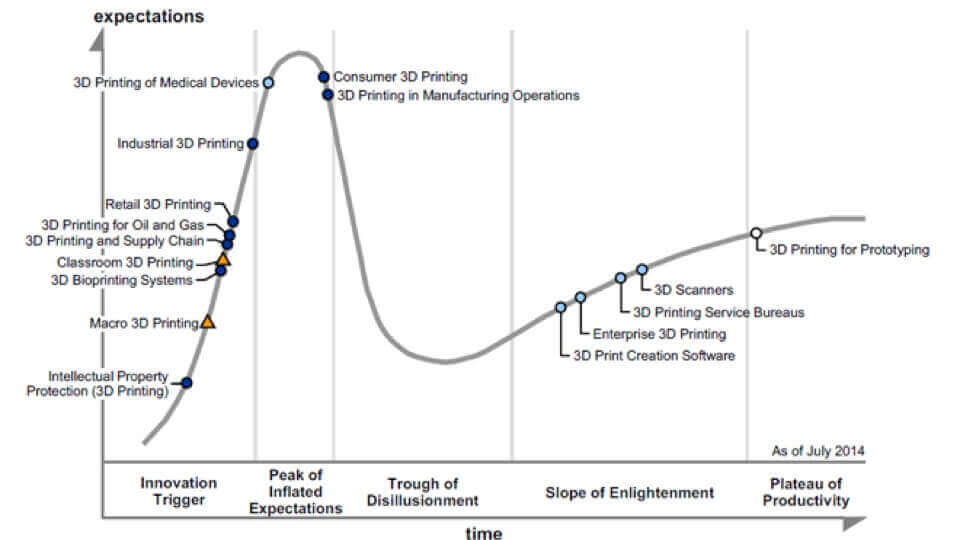
The consulting firm Gartner has kindly provided us with this illustration of the Gartner Hype Cycle, which shows how new technologies are received by the general public and measures the expectations placed on a new technological innovation. Such expectations are influenced by reports about it in the media, by the founding of new enterprises, by new product developments and by the early popularity of the products among their first purchasers.
3D printing is a “new” technology that interests me greatly, but, in fact, it really isn’t all that new. It has been used industrially for over 20 years now, in particular for creating prototypes in the automobile and aviation industries. About 4 years ago, however, producers began developing 3D printers that would make 3D printing attainable and affordable for the general consumer. According to Terry Wohlers, an expert in this field, just under two years ago someone seems to have flipped a switch: 3D printing suddenly entered into the mainstream consciousness and the hype began.

Using the tools from Google Trends we can easily trace how the public perception of 3D printing has been developing. As a glance at today’s trend charts shows: There has been no increase in the number of media reports on 3D printing since autumn of 2013; at best the curve seems to be flattening out. This corresponds to the most recent version of the Gartner Hype Cycle of Emerging Technologies, published in 2014, which put consumer 3D printing on top of the first cycle peak. Gartner was right about that, but we can also expect 3D printing to be expanded into a multitude of additional applications over the coming years. In short, growth rates in the real world, although not reflected in the hype cycle, are steadily rising, even skyrocketing, and despite any falling expectations.
Dozens of new producers have introduced personal or desktop 3D printers onto the market in recent years. Newly founded firms are offering numerous 3D printing services online and in the real world. The “maker” movement and the growing popularity of do-it-yourself are contributing to this rising popularity. The expiration of key patents, innovative zeal and increased financing opportunities for start-ups (for example, over the crowd funding platform Kickstarter, which has gathered pledges to help launch 40 3D projects) had temporarily raised 3D printing to new heights of public awareness. This heightened attention is now going to wane for a time.
That is a normal and healthy development. The marketplace will blow off some steam and exaggerated expectations will diminish. For those who have adopted a long term strategy in the 3D product and service market, this is good news. The view of the market is blurred and distorted during the hype phase and in the subsequent consolidation phase enthusiasm is gradually being replaced by sober analysis. And this analysis shows that 3D printing will become increasingly important – both for industrial and private use.
Mathias Plica is co-founder of All3DP.com.
License: The text of "3D printing passes the first peak of the Hype Cycle – and that’s good!" by All3DP is licensed under a Creative Commons Attribution 4.0 International License.